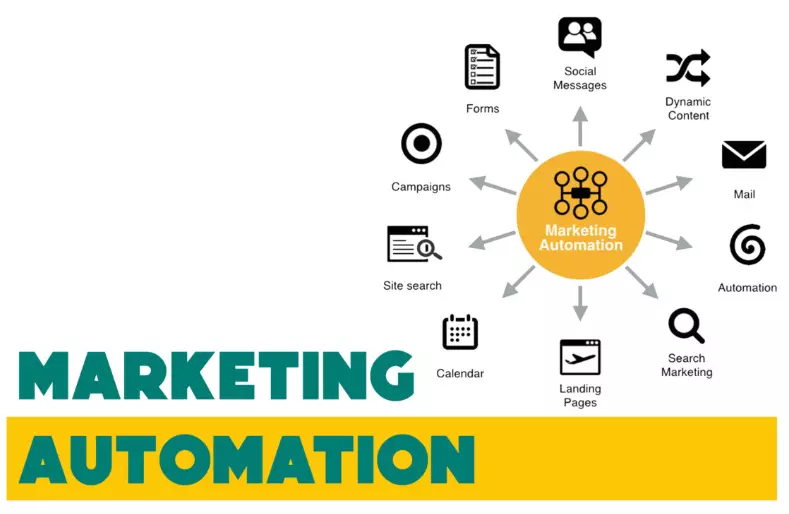Marketing automation and MarTech solutions are primarily sought after for two key reasons: boosting leads and driving increased sales. However, their effective implementation relies on specific conditions. Are these tools a universal fix for acquiring new customers? What prerequisites justify their use? Determining when and which tools to invest in, along with establishing an ecosystem that seamlessly integrates with the company’s CRM, are pivotal considerations addressed in this article.
Marketing automation and MarTech solutions are primarily sought after for two key reasons: boosting leads and driving increased sales. However, their effective implementation relies on specific conditions. Are these tools a universal fix for acquiring new customers? What prerequisites justify their use? Determining when and which tools to invest in, along with establishing an ecosystem that seamlessly integrates with the company’s CRM, are pivotal considerations addressed in this article.
Motivations for MarTech Adoption and Prerequisites for Success
Organizations often turn to MarTech and marketing automation tools due to dwindling leads, a common issue faced after relying on personal networks and favorable market conditions for growth. As companies expand, their reliance on personal contacts reaches a limit, especially in unstable markets. The realization dawns that sustained growth requires more than individual sales prowess and referrals. This triggers the quest for “quick wins” and drives the exploration of MarTech solutions as a panacea.
While these scenarios represent common paths to adopting marketing automation (MA), they’re not exhaustive. The specific route taken matters less than the organization’s maturity in critical areas, pivotal for successful implementation. Ultimately, automation hinges on mature processes, feasible only within adeptly structured organizations.
Let’s Delve into What MarTech Is
MarTech, short for Marketing Technology, refers to a broad range of tools and technologies designed to streamline and enhance marketing efforts. It encompasses software, platforms, and applications that help automate, analyze, and improve various marketing activities. MarTech solutions assist in tasks like customer relationship management, data analytics, content management, social media marketing, email marketing, and more. Essentially, MarTech empowers businesses to optimize their marketing strategies, increase efficiency, and better engage with their target audience through the use of technological tools and innovations.
Organizational Maturity and Marketing Automation Success
Implementing marketing automation software requires a setup akin to driving a race car safely and efficiently. Success hinges on having skilled drivers who can fully leverage the technology. Just like competent pit stop mechanics ensure the car’s optimal performance during breaks, efficient processes and knowledgeable personnel are crucial. Access to vital data—like tire conditions, fuel levels, and lap times—is akin to having essential information to navigate the course successfully.
Similarly, organizations adopting marketing automation or CRM tools need a solid foundation. Without well-established business processes and a functional CRM, the potential of these solutions remains untapped. Without this groundwork, automating operations risks being an expensive endeavor that merely exacerbates disorder. It’s essential to avoid automating chaos, as this could result in losing customers and missing growth opportunities in targeted markets.
The effectiveness of marketing automation tools relies heavily on three areas of organizational maturity:
- 1. Method and Process Competence: This encompasses the maturity of operational methodologies and processes.
- 2. Data Competence: The level of maturity in managing and utilizing data effectively.
- 3. IT Competence: Overall IT maturity within the organization.
There’s a common misconception in many companies that fixing IT competence will solve all issues. In marketing, this often translates to purchasing a marketing automation or MarTech tool and utilizing it extensively, hoping for increased leads. With over 10,000 MarTech tools flooding the market, the allure is strong, yet many of these tools lack reliability and quality data.
Implementing these tools without clear marketing and sales processes often leads to shortcuts that hinder effective communication with potential customers, ultimately resulting in suboptimal outcomes. Successful reference implementations of marketing automation are best learned from experts well-versed in data, marketing, sales processes, and IT architecture.
Lack of clarity in these foundational aspects indicates an organization not yet prepared for automation and likely struggling to measure marketing and sales effectiveness cohesively.
Within the marketing and sales sector, there are five crucial elements to consider, ensuring that investments in tools yield meaningful results.
- Segmentation for Market and Customers:
Understanding your market and customers is crucial. Unclear segmentation can be costly. If your business aims to sell to everyone without a defined audience, automation might not be the answer. Before embracing it, define your Total Addressable Market (TAM), Serviceable Available Market (SAM), and Serviceable Obtainable Market (SOM), and criteria for your ideal customers. Clear market and customer definitions are vital for successful marketing automation.
- Customer Profiles:
For B2C companies, defining target audiences involves creating buyer personas—profiles of potential customers for marketing communications. In B2C, personas are often based on demographic, sociographic, or psychographic data. B2B marketing, dealing with companies as customers, relies on criteria like industry, location, revenue, and more, agreed upon by marketing and sales teams. Buyer personas in B2B represent decision-making committee members influencing service or solution choices. They have objections, challenges, and personal/professional goals affecting their decisions. Various models exist for building buyer personas; the key is selecting a methodology that deeply understands decision-makers for personalized communication. Only this level of personalization should be considered for automation.
- Ideal Customer Profiles (ICP):
The Ideal Customer Profile (ICP) often gets mistaken for Buyer Personas, but it’s more about customer segmentation. It pinpoints the characteristics of the customers most desired to work with, not necessarily the biggest or most prestigious ones. An ICP focuses on the most profitable customers, considering factors like Annual Contract Value (ACV), Lifetime Value (LTV), sales process duration, organizational effort needed for delivery, and more. Analyzing these factors helps identify the customers crucial for stable growth. A clear Ideal Customer Profile (ICP) acts as a roadmap for Account-Based Marketing, allowing the targeting of a specific and high-priority group of potential customers for the organization.
- Lead Definitions:
The terms like Prospect, MQL, SAL, SQL, warm lead, cold lead, and Opportunity can cause confusion due to their varying definitions in the sales and marketing process. There’s no one-size-fits-all definition since it hinges on what’s being sold and to whom. However, alignment in understanding these definitions between marketing and sales is crucial. Consistency ensures both departments work towards generating leads that align with sales requirements. This alignment forms the basis for automating processes, measuring departmental effectiveness, and predicting outcomes.
Defining leads is relatively simpler for B2C businesses, especially in e-commerce, where the salesperson’s role is minimal. B2B, on the other hand, faces complexity. Various criteria—geographic, industry, revenue, organization type, department size—affect individual definitions. The specific offer and targeted customer segments significantly influence the criteria used to classify leads across marketing and sales stages.
- Customer Journey:
An organization’s marketing maturity is often gauged by its automated marketing processes, rooted in understanding the customer journey. Diverse models and tools exist for customer journey mapping, crucial for identifying touchpoints between customers and products/services. These touchpoints aid in tailoring marketing activities to match the expected customer experience at different stages—awareness building, market solution considerations, and purchase.
Effective marketing automation hinges on configuring tailored automations in marketing systems, activated when potential customers intersect with our brand while seeking solutions. Marketing automation thrives in organizations with established, tested, and documented marketing processes. Well-crafted, journey-based funnels launched at opportune moments prove more effective than indiscriminate outreach to large databases where only a small fraction intend to buy.
While automating actions might entice by potentially capturing active buyers, it’s crucial to consider the downsides.Mass automation poses a threat as it might reach only 3% interested in our product while disappointing and spamming the remaining 97%. Consequently, they might refrain from purchasing from us for an extended period. Precision targeting in automation outweighs the allure of bulk outreach for long-term success.
Marketing Automation Tools
Choosing the right marketing automation tool can be overwhelming. Numerous MarTech tools, some affordable for small to medium-sized businesses, offer basic marketing process automation. The choice depends on business scale (B2B or B2C) and the specific processes to automate. Tools like GetResponse, ActiveCampaign, and SALESmanago provide robust features at a reasonable monthly cost, suitable for smaller companies.
For larger businesses, especially those in B2B dealing with intricate products and diverse decision-makers, exploring capabilities of industry leaders is prudent. Globally, Marketo by Adobe, Eloqua by Oracle, and Microsoft Dynamics 365 stand out. Marketo, a rising B2B automation platform, Oracle’s Eloqua, known for its extensive capabilities across varied markets, and Microsoft Dynamics 365, an ecosystem managing diverse business processes including automation, are worth consideration.
HubSpot, recognized for user-friendly interfaces and B2B-focused tools, and Salesforce, a longstanding leader in cloud-based CRM solutions, offer Marketing Cloud for B2C and Pardot for B2B, respectively, solidifying their positions as global leaders in marketing automation solutions.
Choose a Reliable IT Partner
The hierarchy in global marketing automation providers has seen consistency, with Salesforce, Microsoft, and HubSpot vying for the top spot for years. The effectiveness of a particular marketing automation system hinges on the alignment of objectives among the marketing, sales, and IT departments. As emphasized in the piece, the CRM and marketing automation tools’ potential thrives when fueled by high-quality data. Hence, partnering with competent vendors handling a company’s IT systems becomes crucial. To implement or enhance IT systems supporting marketing processes, choosing the right partner marks the initial stride towards success.
Our software development company, iSKY.SOLUTIONS, provides high-quality custom solutions for businesses, consistently aiding clients in automating and optimizing processes while reducing expenses. Our solutions expertise enables us to identify precisely which solutions will help achieve your specific business goals. Don’t hesitate to reach out to us for consultation.


